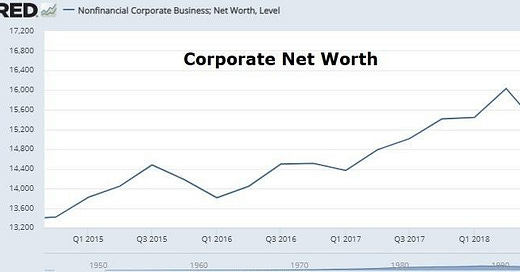With rates on the move, now back to pre-pandemic levels, what's the difference between now and February of last year?
We have an economy producing about the same level of output, utilising about the same level of capacity. Household net worth is at record highs and by the end of the year, the CBO (Congressional Budget Office) is projecting the U.S. economy will grow at a 3.7% annualized rate (hotter than pre-pandemic growth). They also project that unemployment will fall to 5.3% this year, about right at the average unemployment rate of the past 50 years.
But corporate net worth is down, about $1.2 trillion from last February.
U.S. government net worth is down $2.2 trillion as of the end of Q3 - we know that number continues to rise.
So, how do politicians and central banks fix this discrepancy? Inflation. Inflate the nominal value of assets and output...and inflate away the cost of debt. With that, most charts you pull up these days look like a nice 45 degree line from the bottom left to the top right of the screen (if not a hockey stick). These charts clearly demonstrate the “inflating” of assets.
What's not participating in this “inflating everything” market? The one market that should be on fire, given the situation laid out above: gold.
Gold has had five consecutive lower daily closes, now trading down to $1776 - that's down ~14% from the August 2020 record highs.
Given the explicit devaluation of cash (through unlimited Fed QE and seemingly unlimited deficit spending aspirations), this is a correction to buy. It’s a second chance.
How do you play it? Get leveraged exposure to gold through gold miners, or track the price of gold through an ETF, like GLD.





